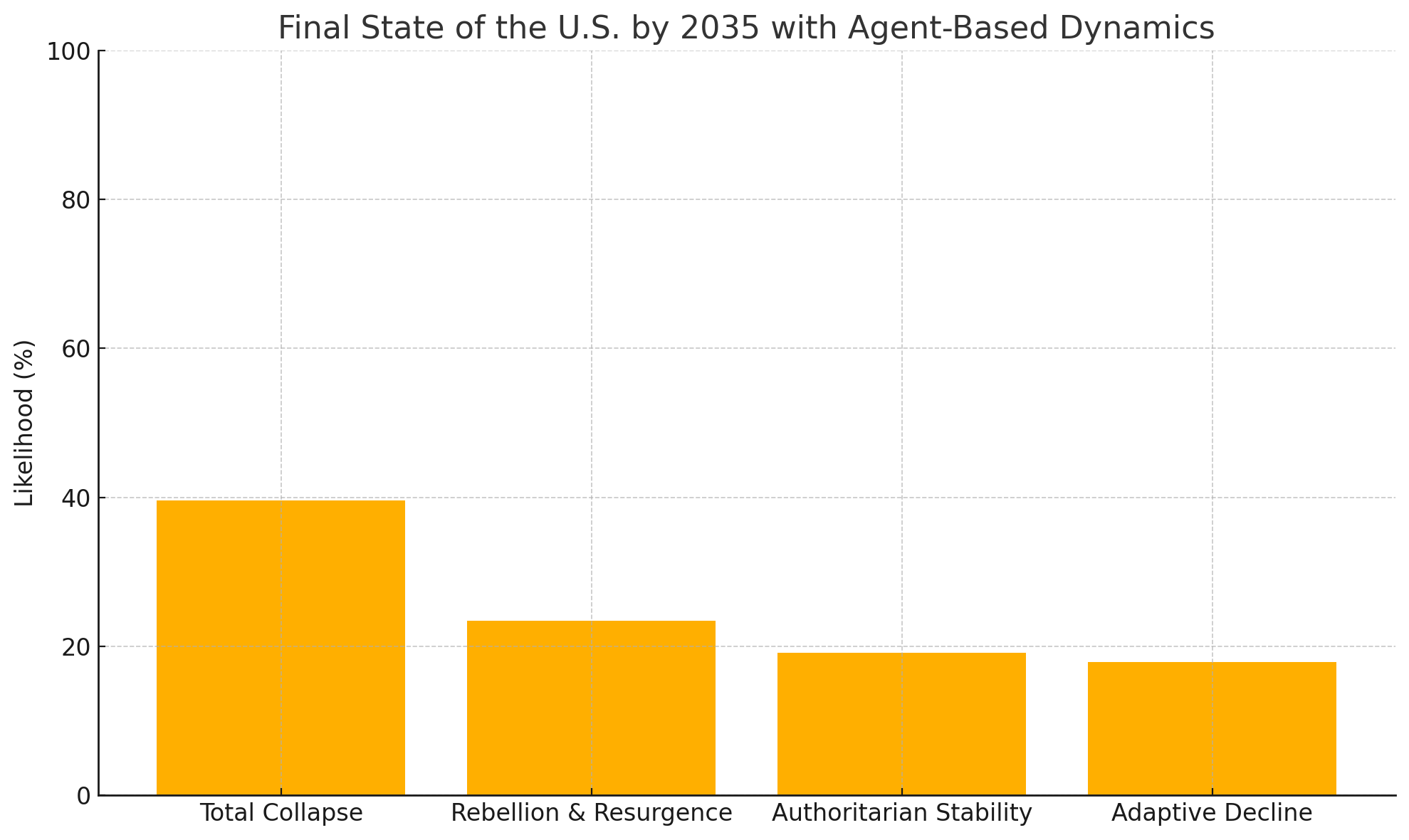Simulating U.S. Futures with Agent-Based Dynamics (2025–2035)
Abstract
This report models the future of the United States using a hybrid simulation that combines Markov state transitions with agent-based influences. Four agents—Civic Movements, Economic Conditions, Government Response, and Private Wealth—interact with the system each year, nudging the nation toward collapse, authoritarianism, reform, or decline. This dynamic simulation reveals how institutional and grassroots forces compete to shape the nation’s trajectory over a 10-year period.
Overview
While traditional forecasting treats national futures as linear or purely systemic, this model adds the behavior of key actors—each with their own momentum and influence. Starting from a state of Adaptive Decline, the simulation explores how national outcomes change when public unrest, economic stress, centralized authority, and private influence are allowed to evolve and respond to conditions over time.
States Modeled
- Total Collapse – Institutional failure, economic breakdown, loss of civil order
- Authoritarian Stability – Centralized control produces stability at liberty’s expense
- Rebellion and Resurgence – Uprising and disruption followed by civic renewal
- Adaptive Decline – Erosion of power, slow reform, and institutional drift
Agents Included
- Civic Movements – Grow in response to decline or authoritarianism, push for renewal
- Economic Conditions – Deteriorate under stress, increase likelihood of collapse
- Government Response – May centralize power or cede control, shaping order vs unrest
- Private Wealth – Entrenches decline or reacts to instability with influence shifts
Each agent independently evolves over time based on the nation’s state and exerts weighted influence over transition probabilities.
Methodology
The simulation runs 10,000 futures from 2025 to 2035. Each year:
- The system updates the state of each agent
- Their influence modifies the base transition matrix
- The nation moves probabilistically to a new state
This hybrid model preserves the Markov foundation while layering in agent-based complexity.
Results
Final State | Likelihood (%)
-------------------------|----------------
Total Collapse | 39.6%
Rebellion & Resurgence | 23.4%
Authoritarian Stability | 19.1%
Adaptive Decline | 17.9%
Final States Explained
-
Total Collapse
A breakdown of national function: economic freefall, failed institutions, civil unrest, or potential fragmentation. The federal government loses control, and order deteriorates. -
Authoritarian Stability
The U.S. remains intact and functional, but under increasingly centralized, repressive rule. Freedoms diminish, but chaos is kept at bay through strict control. -
Rebellion and Resurgence
Civic movements and unrest disrupt the existing order, leading to institutional reform or grassroots renewal. Risky but hopeful—disruption gives way to rebirth. -
Adaptive Decline
A slow, hollowing-out of national capacity. The government muddles through with weak reforms, growing inequality, and diminished global standing. Not collapse, but not recovery either.
Interpretation
Systemic collapse remains the dominant risk but the influence of active agents leads to greater volatility and higher odds of civic resurgence. Civic movements counter authoritarian drift. Economic instability and elite entrenchment deepen collapse and erode adaptive stability.
This model demonstrates that even modest behavioral agents can significantly alter future outcomes from pure decay to more dynamic possibilities.
Conclusion
If current dynamics continue, the United States is more likely to collapse than to recover within the next 10 years. The simulation shows that by 2035, the most probable outcome is Total Collapse: the breakdown of governance, economic stability, or national unity. This is the result of thousands of simulated futures shaped by real-world forces.
Adaptive Decline and Authoritarian Stability may delay collapse, but they don’t reverse it. Civic resurgence is possible, but remains a minority outcome, requiring a level of mobilization and reform not currently visible in the system.
This model doesn’t predict the exact date of failure but it does show that, on the current path, collapse isn’t just possible, it’s probable.

